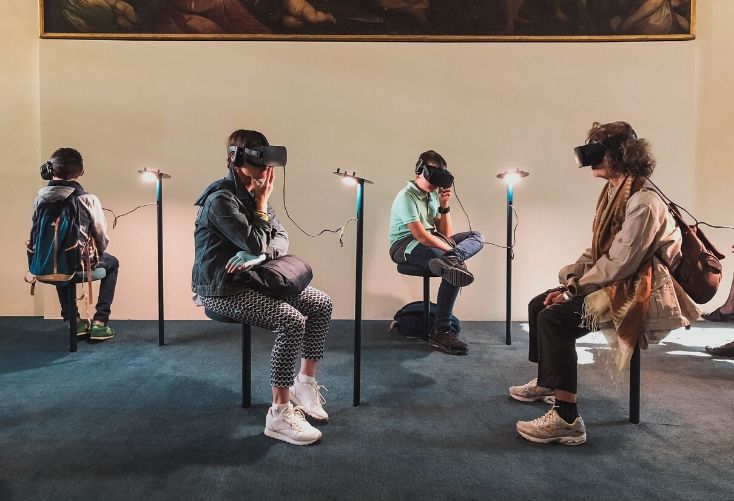- The health crisis is accelerating digital trends that initially seemed many years away.
- Among them, virtual experiences could enable business events, meetings and team collaboration to happen safely.
- Here’s how 3D holographic images, avatars and other AR/VR technologies could become commonplace.
Many people believe the pandemic will act as a catalyst for trends that were beginning to emerge yet seemed years away from entering the mainstream. Leading consumer trend firm, Trend Watching, lists ten such accelerating trends in one of their recent articles.
First on the list is the “virtual experience economy” – immersive technologies that enable people to participate in location-based experiences in the virtual environment. For instance, unable to attend sporting events, concerts and theatre productions, many of us are turning to live virtual alternatives via video and some of us are using virtual reality headsets.

Holographic transportation for business events
Most of us are aware of the audio visual technologies that enable businesses to interact with remote workers, such as LCD projectors and screens. However, as businesses replace centralised teams with dispersed ones, 3D holographic images, avatars and other AR/VR technologies could become commonplace.
Suggested Reading: How AR and VR Will Change Our Workspaces
Holograms have taken centre stage – literally – in the music business in recent years. Maria Callas, Tupac Shakur, Roy Orbison and more recently Whitney Houston have taken to the stage in holographic form, although Houston’s European tour dates have been canceled due to governmental orders and restrictions in response to the pandemic.
As well as concerts, holographic technology is being used in the world of business meetings and conferences. Following recent events and as soon as it becomes more affordable, even more businesses are expected to embrace it.
In this video, a Microsoft representative demonstrates the use of AI neural text-to-speech (TTS) and holograms in a keynote context.
DVE Holographics has been at the forefront of innovation in holographic transportation for almost 20 years.
Suggested Reading: Holoportation Hits the Workplace to Save AR
An early version of live holographic telepresence was proven when DVE teleported live Stephen Hawking from his home in Cambridge, UK to the Sydney Opera House. Since then, the technology has evolved into an ultra-realistic visual experience.
Now, the firm’s HDR Studio Stage™ is providing businesses with a unique way to deliver business conferences and events while reducing the need for social contact.
Speakers appear live on stage from their home or workspace on a real event stage (typically an empty hotel and convention center space), and are streamed to up to tens of thousands of online attendees.
Stephen Hawking at the Sydney Opera House in 2015:
According to Oxford Economics, more than one trillion dollars in direct spending every year is generated by business conferences, and the HDR Studio Stage™ could be a crucial resource in enabling the sector to continue during and following the health crisis.
“For many years our developments in holographic telepresence was a glimpse of the technology of the future. It is now obvious that what we do is vital to connect people and may become, in part, a new normal.
Our aim is to help elevate our colleagues in the business conference event industry during this difficult time and keep the wheels of our industry turning. Corporations now have a virtualized event alternative that enables them to think big and to create quality productions for their streaming events.”
Steve McNelley, CEO of DVE
DVE’s Immersion Room:
Holographic conferences are a big expense, but it might be a worthwhile one for businesses in the entertainment, marketing and events production industries. It’s still a novelty and has the potential to attract new customers or clients.
Smaller companies or those operating in different industries might want to consider technologies like the Microsoft HoloLens – “an untethered mixed reality device with apps and solutions that enhance collaboration”.
Holographic transportation for meetings
As well as larger events, holographic projection has the potential to enhance business meetings.
Organisations can save money by hosting meetings remotely without completely compromising the benefits associated with face-to-face interaction, such as higher engagement rates. Also, replacing in-house meetings and seminars with virtual ones means more people can join in, making them more inclusive.


 Dr. Gleb Tsipursky – The Office Whisperer
Dr. Gleb Tsipursky – The Office Whisperer Nirit Cohen – WorkFutures
Nirit Cohen – WorkFutures Angela Howard – Culture Expert
Angela Howard – Culture Expert Drew Jones – Design & Innovation
Drew Jones – Design & Innovation Jonathan Price – CRE & Flex Expert
Jonathan Price – CRE & Flex Expert













